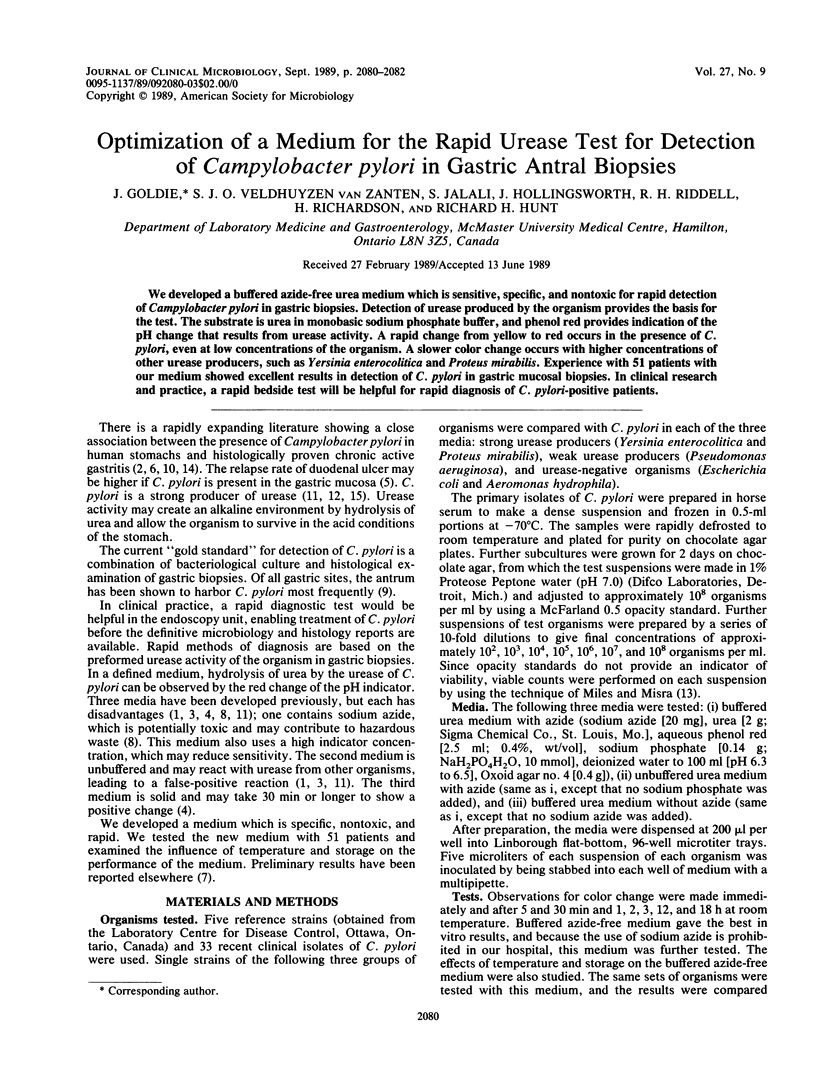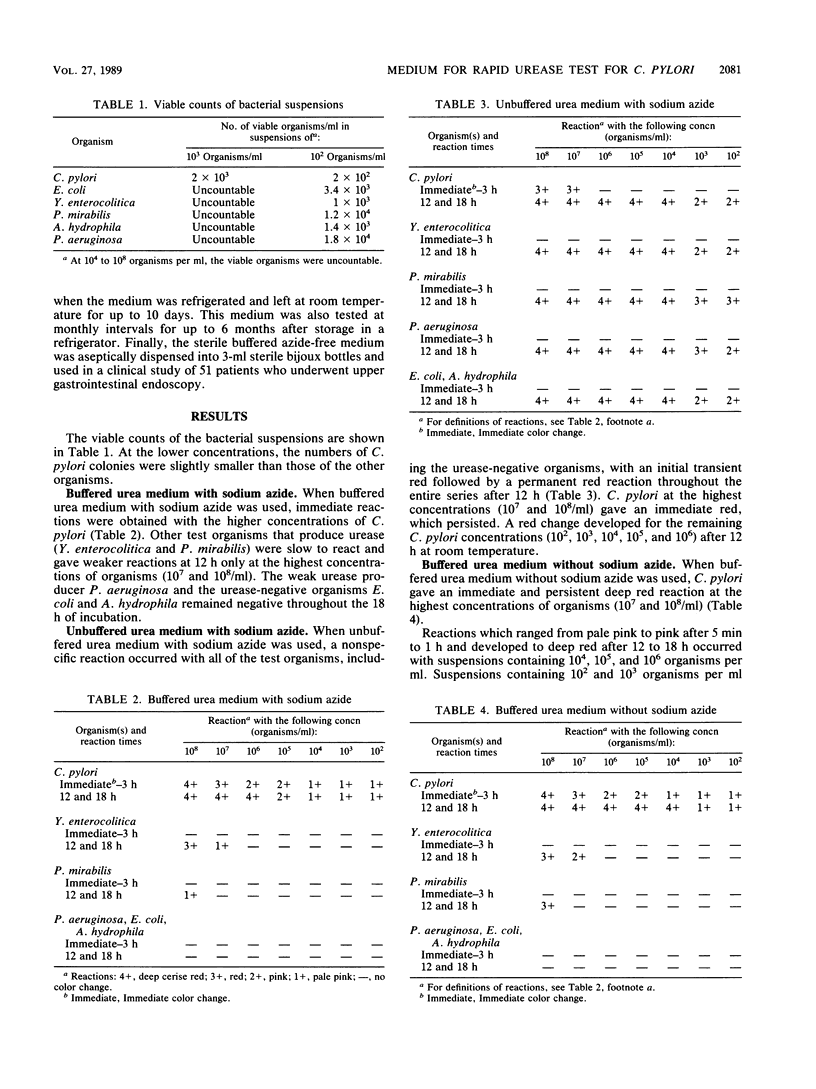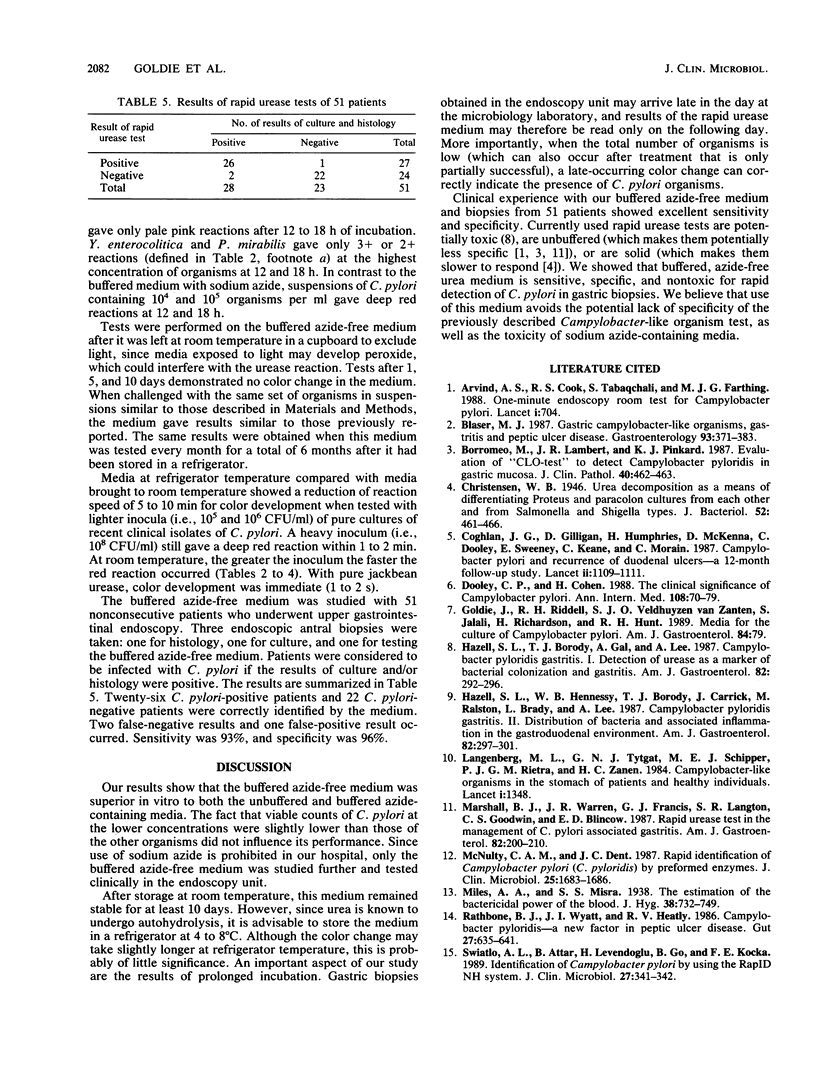Abstract
We developed a buffered azide-free urea medium which is sensitive, specific, and nontoxic for rapid detection of Campylobacter pylori in gastric biopsies. Detection of urease produced by the organism provides the basis for the test. The substrate is urea in monobasic sodium phosphate buffer, and phenol red provides indication of the pH change that results from urease activity. A rapid change from yellow to red occurs in the presence of C. pylori, even at low concentrations of the organism. A slower color change occurs with higher concentrations of other urease producers, such as Yersinia enterocolitica and Proteus mirabilis. Experience with 51 patients with our medium showed excellent results in detection of C. pylori in gastric mucosal biopsies. In clinical research and practice, a rapid bedside test will be helpful for rapid diagnosis of C. pylori-positive patients.
Full text
PDF


Selected References
These references are in PubMed. This may not be the complete list of references from this article.
- Arvind A. S., Cook R. S., Tabaqchali S., Farthing M. J. One-minute endoscopy room test for Campylobacter pylori. Lancet. 1988 Mar 26;1(8587):704–704. doi: 10.1016/s0140-6736(88)91501-2. [DOI] [PubMed] [Google Scholar]
- Blaser M. J. Gastric Campylobacter-like organisms, gastritis, and peptic ulcer disease. Gastroenterology. 1987 Aug;93(2):371–383. doi: 10.1016/0016-5085(87)91028-6. [DOI] [PubMed] [Google Scholar]
- Borromeo M., Lambert J. R., Pinkard K. J. Evaluation of "CLO-test" to detect Campylobacter pyloridis in gastric mucosa. J Clin Pathol. 1987 Apr;40(4):462–463. doi: 10.1136/jcp.40.4.462. [DOI] [PMC free article] [PubMed] [Google Scholar]
- Campylobacter-like organisms in the stomach of patients and healthy individuals. Lancet. 1984 Jun 16;1(8390):1348–1349. [PubMed] [Google Scholar]
- Christensen W. B. Urea Decomposition as a Means of Differentiating Proteus and Paracolon Cultures from Each Other and from Salmonella and Shigella Types. J Bacteriol. 1946 Oct;52(4):461–466. doi: 10.1128/jb.52.4.461-466.1946. [DOI] [PMC free article] [PubMed] [Google Scholar]
- Coghlan J. G., Gilligan D., Humphries H., McKenna D., Dooley C., Sweeney E., Keane C., O'Morain C. Campylobacter pylori and recurrence of duodenal ulcers--a 12-month follow-up study. Lancet. 1987 Nov 14;2(8568):1109–1111. doi: 10.1016/s0140-6736(87)91545-5. [DOI] [PubMed] [Google Scholar]
- Dooley C. P., Cohen H. The clinical significance of Campylobacter pylori. Ann Intern Med. 1988 Jan;108(1):70–79. doi: 10.7326/0003-4819-108-1-70. [DOI] [PubMed] [Google Scholar]
- Hazell S. L., Borody T. J., Gal A., Lee A. Campylobacter pyloridis gastritis I: Detection of urease as a marker of bacterial colonization and gastritis. Am J Gastroenterol. 1987 Apr;82(4):292–296. [PubMed] [Google Scholar]
- Hazell S. L., Hennessy W. B., Borody T. J., Carrick J., Ralston M., Brady L., Lee A. Campylobacter pyloridis gastritis II: Distribution of bacteria and associated inflammation in the gastroduodenal environment. Am J Gastroenterol. 1987 Apr;82(4):297–301. [PubMed] [Google Scholar]
- Marshall B. J., Warren J. R., Francis G. J., Langton S. R., Goodwin C. S., Blincow E. D. Rapid urease test in the management of Campylobacter pyloridis-associated gastritis. Am J Gastroenterol. 1987 Mar;82(3):200–210. [PubMed] [Google Scholar]
- McNulty C. A., Dent J. C. Rapid identification of Campylobacter pylori (C. pyloridis) by preformed enzymes. J Clin Microbiol. 1987 Sep;25(9):1683–1686. doi: 10.1128/jcm.25.9.1683-1686.1987. [DOI] [PMC free article] [PubMed] [Google Scholar]
- Rathbone B. J., Wyatt J. I., Heatley R. V. Campylobacter pyloridis--a new factor in peptic ulcer disease? Gut. 1986 Jun;27(6):635–641. doi: 10.1136/gut.27.6.635. [DOI] [PMC free article] [PubMed] [Google Scholar]
- Swiatlo A. L., Attar B., Levendoglu H., Go B., Kocka F. E. Identification of Campylobacter pylori by using the rapID NH system. J Clin Microbiol. 1989 Feb;27(2):341–342. doi: 10.1128/jcm.27.2.341-342.1989. [DOI] [PMC free article] [PubMed] [Google Scholar]


